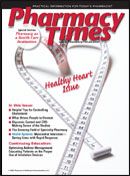Publication
Article
Pharmacy Times
2-Minute Consultation: Hypotension Calls for Aggressive Monitoring
Author(s):
As with hypertension, clinicians must aggressively monitor hypotension, which is associated with many serious conditions.
Dr. Zanni is a health systems consultantand psychologist based in Alexandria,Virginia.
Up to 30% of individuals are hypotensive1,2with elders disproportionatelyaffected.3 Becausehypotension is associated withParkinson's disease, stroke, transientischemic attacks, myocardial infarction,electrocardiogram abnormalities, andAlzheimer's disease, these patients mayask about hypotensive symptoms.4-6
To diagnose hypotension, cliniciansrecord blood pressure (BP) every minutefor 5 minutes after patients have laindown for 15 minutes and then stand. Ifsystolic BP falls more than 20 mm Hg, ordiastolic BP falls more than 10 mm Hg,hypotension is present.4
Orthostatic hypotension (OH) developswhen systems fail to compensatefor the approximately 500-mL decreasein blood routed to the heart as a personstands, and blood pools in the extremities.6 Up to 50% of OH is drug-induced.7Hypovolemia induced by excessivediuretic use is the most common causeof OH.7 Patients' drug regimens shouldbe screened for antihypertensives,monoamine oxidase inhibitors, tricyclicantidepressants, antianginals, levodopa,dopamine, selegiline, barbiturates, andalcohol. 4,7,8
Postprandial hypotension (PPH)is observed only in elders9,10 and maycause syncope, falls, dizziness, fatigue,angina pectoris, stroke, and myocardialinfarction.11 PPH is most likely to occurafter breakfast.12,13
Pharmacists should be prepared todiscuss both pharmacologic (Table 1)and nonpharmacologic (Table 2) interventionsthat achieve adequate functionalcapacity (and not necessarily aspecific BP reading).8 As with hypertension,clinicians must aggressively monitorhypotension.
Table 1
Pharmacologic Hypotension Treatments
Fludrocortisone: 0.1-0.4 mg daily for at least 2 weeks stimulates renal sodium retention; sodium supplementation may be needed. Side effects include weight gain of up to 8 lb, hypokalemia, hypomagnesemia, and supine hypertension. Monitor warfarin interactions.
Midodrine: to prevent peripheral resistance and venous pooling in neurogenic and dialysisrelatedhypotension, 2.5 mg with breakfast and lunch, increasing by 2.5 mg 3 times daily every2 days, to a maximum of 30 mg daily will elevate standing systolic BP 15 to 30 mm Hg within 1hour for up to 3 hours. Administer doses during the day while the patient is active. Adverseeffects include pilomotor reactions, paresthesia, pruritus (especially the scalp), distrait (hesitancyand retention), and chills. To avoid supine hypertension, schedule the last dose of theday before 6 pm or 4 hours before bedtime. It interacts with digoxin, calcium channel blockers,and beta-blockers, and is contraindicated with alpha-adrenergic receptor stimulators. It mayantagonize the alpha-adrenergic blockers.
Erythropoietin: although unapproved for hypotension, increases red blood cell volume, andsometimes corrects OH. Include concurrent iron supplementation to prevent iron deficiencyanemia.
Octreotide: a somatostatin analogue, decreases splanchnic blood flow and increases BP.In PPH, initial doses of 50 ?g subcutaneously are used 30 minutes before meals for 2 weeks.If response occurs, a monthly depot injection can be used. Octreotide can alter dietary fatabsorption, and depress B12 levels.
BP = blood pressure; OH = orthostatic hypotension; PPH = postprandial hypotension.
Adapted from references 4,8,9,12.
Table 2
Nonpharmacologic Hypotension Treatments
Eat small, frequent, low-carbohydrate meals early in the day and consume larger meals late inthe day, when BP tends to be higher.
Exercise before meals to improve vascular tone and reduce venous pooling.
Use muscle tensing. When hypotension begins, crossing legs can increase BP by 13 mm Hg, orsquatting can increase BP 44 mm Hg.
Increase sodium intake 5-10 g above recommended dietary levels.
Increase fluid intake. Consuming 480 mL of water can increase seated BP 11 mm Hg in healthyelders and 43 mm Hg in elders with autonomic failure. Response occurs within 5 minutes,peaking 25 minutes later.
Use elastic stockings.
Avoid alcohol.
Elevate the head of the bed approximately 20o (about 8 inches).
Avoid abrupt positional changes and long periods of inactivity.
Although controversial, some clinicians recommend 2 cups of coffee in the morning (caffeineis a phosphodiesterase inhibitor). Caffeinated beverages should be consumed before mealsrather than with meals.
BP = blood pressure.
Adapted from references 4,8,12-15.
References
- Harris T, Lipsitz LA, Kleinman JC, Cornoni-Huntley J. Postural change in blood pressure associated with age and systolic blood pressure: The National Health and Nutrition Examination Survey II. J Gerontol. 1991;46(5):M159-M163.
- Tilvis RS, Hakala SM, Valvanne J, Erkinjuntti T. Postural hypotension and dizziness in a general aged population: a four-year follow-up of the Helsinki aging study. J Am Geriatri Soc. 1996;44(7):809-814.
- Montastruc JL, Laborie I, Bagheri H, Senard JM. Drug-induced orthostatic hypotension: a five-year experience in a regional pharmacovigilance centre in France. Clin Drug Invest. 1997;14(1):61-65.
- Senard JM, Brefel-Courbon C, Rascol O, Montastruc JL. Orthostatic hypotension in patients with Parkinson's disease: pathophysiology and management. Drugs Aging. 2001;18(7):495-505.
- Qiu C, von Strauss E, Fastbom J, Winblad B, Fratiglioni L. Low blood pressure and risk of dementia in the Kungsholmen project: a 6-year follow-up study. Arch Neurol. 2003;60(2):223-228.
- Luukinen H, Koski K, Laippala P, Kivela SL. Prognosis of diastolic and systolic orthostatic hypotension in older persons. Arch Intern Med. 1999;159(3):273-280.
- Cardiovascular Disorders: Orthostatic hypotension and syncope. The Merck Manual of Diagnosis and Therapy [online edition]. www.merck.com/mmpe/sec07/ch069/ch069d.html#sec07-ch069-ch069d-10. Accessed October 24, 2008.
- Frishman WH, Azer V, Sica D. Drug treatment of orthostatic hypotension and vasovagal syncope. Heart Dis. 2003;5(1):49-64.
- Cruz DN. Midodrine: a selective alpha-adrenergic agonist for orthostatic hypotension and dialysis hypotension. Expert Opin Pharmacother. 2000;1(4):835-840.
- Lipsitz LA, Nyquist RP Jr, Wei JY, Rowe JW. Postprandial reduction in blood pressure in the elderly. N Engl J Med. 1983;309(2):81-83.
- Bou-Holaigah I, Rowe PC, Kan J, Calkins H. The relationship between neurally mediated hypotension and the chronic fatigue syndrome. JAMA. 1995(12);274:961-967.
- O'Mara G, Lyons D. Postprandial hypotension. Clin Geriatr Med. 2002;18(2):307-321.
- Morley J. Editorial: Postprandial hypotension-the ultimate Big Mac attack. J Gerontol A Biol Sci Med Sci. 2001;56(12):M741-M743.
- Jordan J, Shannon JR, Black BK, et al. The pressor response to water drinking in humans: a sympathetic reflex? Circulation. 2000;101(5):504-509.
- Zoler ML. Water consumption can boost low blood pressure. Fam Prac News. 2001;31(3):11.







